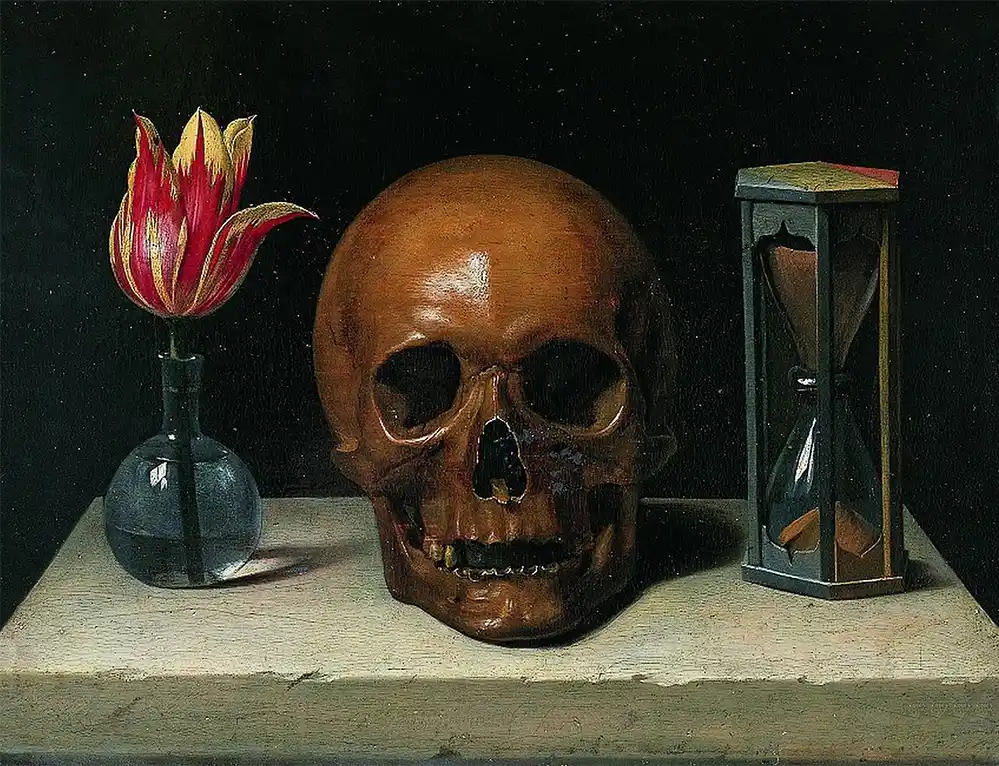Death can be described as the permanent cessation of life. It happens when all biological functions that sustain the living of an organism cease.
The event marks the end of life, and that it is irreversible.
Death can happen through variety of reasons, and every living thing will experience death. It's only a matter of time before it happens, and how. In all, death is usually defined as the lack of functions and activities in the brain and the brainstem, when breathing ceased, and the heart stops beating. Soon after this, the remains of the former organism will start decomposing.
Humanity has long been fascinated by death.
From how cultures depict death in arts, among others, death is also a mystery, and even considered a being or otherwise personified. Because of this, humanity's fascination with death is a complex aspect of human nature that has been explored in various ways throughout history.

People are captivated by death, because death is a symbol of uncertainty about what happens after life. This makes death the point of no return that captivates human curiosity.
After all, contemplating death often leads to philosophical reflections on the meaning and purpose of life. It pushes individuals to consider their own existence and the finite nature of life.
Cultural and religious perspectives also play a significant role.
It also raise awareness of one's mortality.
Because death is inevitable for all living things, some people fear death. And by becoming fascinated by death, it's one of the ways for those people to confront and cope with this fear.
But death isn't something that can be predicted.
And this is changed with the internet, which allows people who are fascinated with death, to witness death whenever they "please."
This is why death has also attracted a lot of attention on the internet, which in turn sparked controversies.
There are various online communities that share and watch videos of real people dying, often in gruesome and violent ways.
While some people in these communities claim to have a morbid curiosity, a fascination with the darker aspects of human nature, or a desire to confront their own mortality, others may have more sinister motives, such as sadism, voyeurism, or exploitation.
Due to the high demand of witnessing death, a number of platforms, especially those that are community-based with content that is user-generated, have dedicated places for these audience.
From the now-defunct Rotten and BestGore, which were regarded as the pioneers in this category, had sparked interest that spread to Reddit and influenced the creations of more websites dedicated to gore and death.
These are just some of the examples of the internet communities that love uploading death and watching people die.
Because of this, the so-called "shock sites" rest on the soft white underbelly of the web.
They thrive from a particular audience that seem to have interest in the deep-red color of blood, dismembered limbs, broken bones and skulls, beheading and splattered organs.
When accidents happened, like when suicides are witnessed, mass shootings occurred, mishaps done, there are always people on the web who seek either or both the photos and videos of the gruesome aftermaths.
From the death of Tangmo Nida, the famous model and actress who allegedly drowned; the death of Wu Yongning, whose death sparked a lawsuit to stop what "crowdfunded" his death; the murder of Bianca Devins, and how her death was exploited on the internet, the fatal car accident involving Vanessa Angel, the Indonesian actress' demise which made a lot of YouTubers to create content on the location of her death; the death of Brandon Vedas, who overdosed while live online, the suicide of Ronnie McNutt, who killed himself with a shotgun while live online, the suicide of Kevin Whitrick, who hanged himself while live on a chatroon at PalTalk, and lots more.
Let's not forget the first-ever suicide livestreamed on TikTok, and the 12-year-old girl who livestreamed herself while she hanged herself, and the murder of Christine Silawan, the girl who forced the Philippines to make her name a banned internet keyword, and the New Zealand's Christchuch mass shooting that made online platforms struggling to contain.
Then, there is 'Funkytown', which is considered one of the goriest videos the internet has ever seen; and MDPOPE, which sets a goal of becoming the "Most Disturbed Person On Planet Earth."
People view these content about death and made them viral, with the feelings of curiosity, guilt, but often, also paired with excitement and revulsion.
These communities have raised ethical, moral, and legal questions about the consumption and distribution of death on the internet.
Read: India Bans TikTok Because The Platform Turns People Into Murderers

Some of the issues that have been debated are:
- The consent and privacy of the victims and their families: Many of the videos and images of death are obtained without the permission or knowledge of the people involved or their loved ones.
Some of the videos are leaked by authorities, hackers, or witnesses who may have motives. Some of the videos are even staged or provoked by the perpetrators who seek fame and online engagements. These actions violate the dignity and rights of the victims and their families, who may suffer additional trauma and harassment from the exposure of their tragedy.
This happens, partly because the victims are shown in their most vulnerable state, depicted naked or partly clothed, with their genitals exposed. And in many cases, not only adults become the content of death because children are also depicted.
- The psychological and social effects of the viewers: Many of the viewers of death on the internet may experience negative emotions and reactions, such as fear, disgust, anger, sadness, or guilt. Some of the viewers may become desensitized, numb, or indifferent to the suffering of others. Some of the viewers may develop unhealthy or harmful behaviors, such as addiction, obsession, imitation, or aggression.
These effects may impair the mental health and well-being of the viewers, as well as their relationships and interactions with others.
- The legal and ethical responsibility of the platforms and creators: Many of the platforms and content creators that post death on the internet may face legal and ethical challenges, such as censorship, regulation, prosecution, or boycott.
Some of the platforms and creators may claim to have a right to freedom of expression, information, or education. Some of the platforms and creators may argue that they provide a public service, a catharsis, or a warning. These claims may conflict with the laws and norms of different countries, cultures, and communities, as well as the values and morals of different individuals and groups.

Death on the internet is a complex and controversial phenomenon that reflects the dark side of human nature and technology.
It is far from being a new phenomenon, as humans have always been fascinated and terrified by death, but it is a phenomenon that has been amplified and diversified by the internet.
This fact has created its own term, called the "cyberthanathology," which combines the elements of "cyber," which depicts the characteristic of the culture of computers and information technology, and "thanathology," which is derived from the Greek word "thanatos," meaning death.
Putting it together, the term cyberthanathology implies the unique intersection of technology or the digital world with the study, and internet users' fascination of death.
It is a phenomenon that poses many questions and challenges for the society and the individual, as well as for the future of the internet and humanity.
